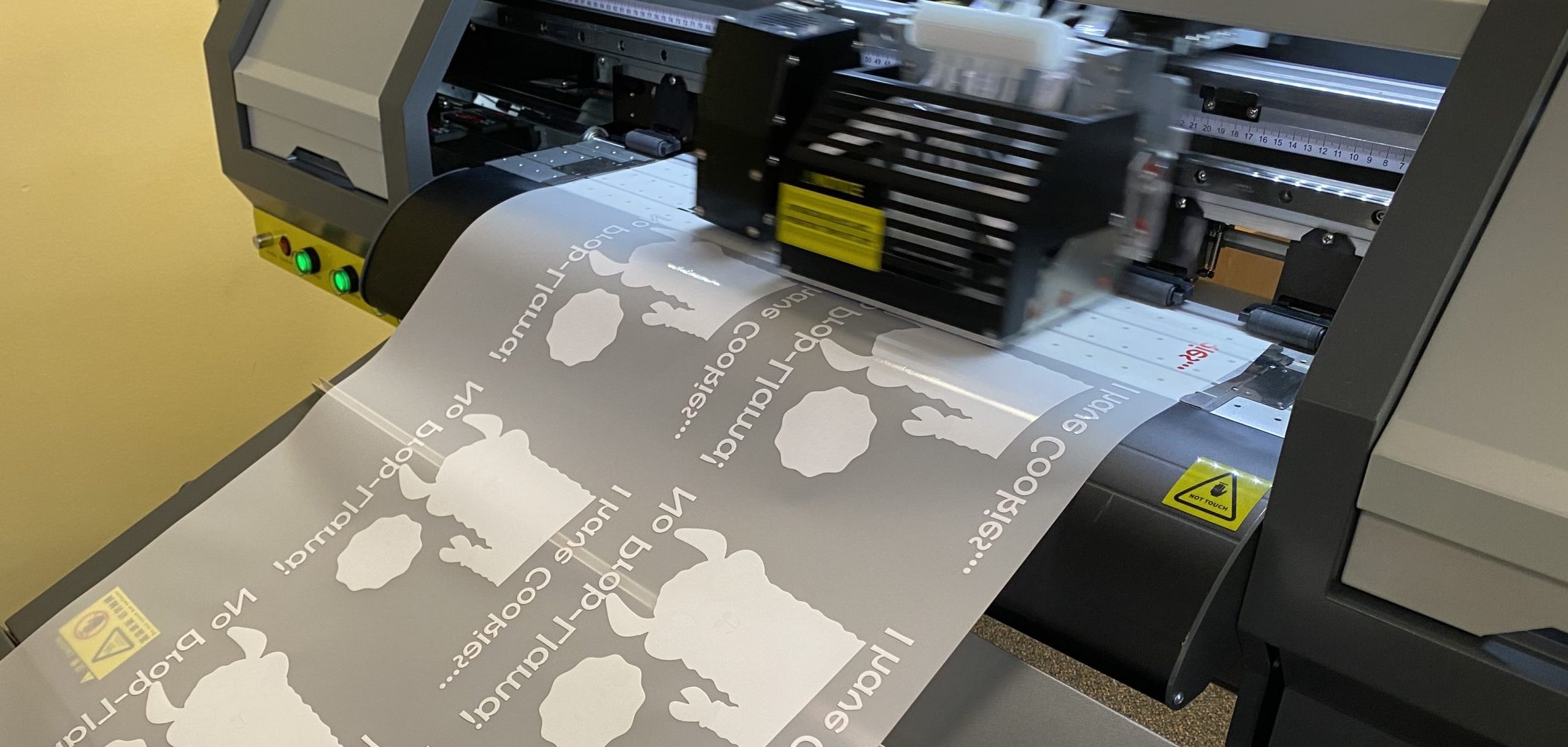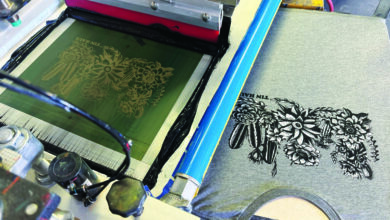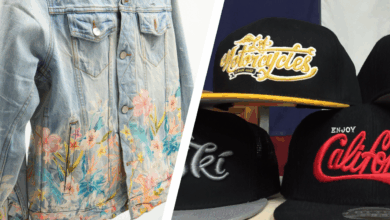More and more, the apparel and accessories marketplace is feeling the pressure to produce custom or semi-custom products quickly, efficiently, and for less. Over the years, the process has run the gamut from direct screen printing — which required tedious setup, from artwork, separations, films, and burning screens to reclaiming screens and cleanup after production — to the move to direct digital imaging with direct-to-garment (DTG) printers doing one or two off prints at a time. Neither of these processes solves all the problems associated with “just in time” apparel and accessory decoration. Too much time and labor associated with screen printing for short runs (especially when considering one off printing) as well limitations in colors, too much equipment, and the labor costs associated with DTG when doing larger runs may not justify the expense and effort of screen printing. Top this off with the need to hire and/or train more skilled workers, this then means higher payroll costs.
Examples where middle to high-volume custom/semi-custom decoration are required include websites that allow custom designing with no minimums, team sports, special events items like bachelorette parties, IMO (in memory of) shirts, team shirts for fundraiser events, family reunions, etc. On the other side, would be licensed or stock designs that become more valuable when offered on the widest selection of garments possible. In the past, your options would be to try to have an inventory of preprinted garments in a wide variety of colors, sizes, and styles or to try to produce these items one at a time on somewhat expensive, space-consuming DTG printers that also come with limitations in the types of fabric they will effectively print onto (mostly cotton and cotton blends are used as synthetics and performance wear do not work).
The problem is straightforward:
- The market demands variety, full color, moderate to extreme level of customization, quick turnaround, and competitive pricing.
- Existing methods range from labor-intensive processes like screen printing and digital printing methods like DTG, which are limited by fabric type, inefficient in terms of space, and associated with higher equipment costs and higher labor costs due to the skill level required by operators.
- The marketplace is looking for an equipment solution that is:
- Inexpensive to purchase and operate
- Easy to master
- Offers full customization abilities
- Makes efficient use of space
- Produces output quickly
- In addition, the marketplace needs software and workflow solutions that integrate with their order systems to reduce the need for unnecessary human interface —from the order to production stage.
- Lastly, there is a need and desire to keep labor costs down by reducing the need for highly skilled operators.
The solution is also straightforward: A DTF – Direct-to-film printer that can produce 150-300 square feet of output per hour. This would result in:
- Virtually unlimited fabric options
- A time-proven transfer process (same adhesive solution as used in screen printed transfers)
- A quick and simple pressing solution (10-15 seconds) not requiring highly skilled operators
- Low output costs
- The ability to produce three to five times the output in the same workspace as compared to DTG printing
- No pretreatment process required
- Software solutions for variable data, images, serialization, and bar/QR coding
- Training and support from a trusted industry provider with years of collective experience in the apparel, equipment, and graphics industry
Overview of DTF printing
DTF printing has very quickly become a reality. In the last two years, it has grown from a wildcat solution based on converted Epson desktop printers and manual shake and bake adhesion application to purpose-built printers, adhesive applicators, and adhesive curing dryers.
Digital images are printed face down and topped with white ink which remains tacky until an adhesive powder is cascaded on the prints with the excess vibrated off and then cured. The finished images are trimmed and pressed (10-20 seconds) with results that are equal in durability and feel to direct-print screen printing.
In-depth explanation of DTF printing
DTF printing uses inkjet printers to print aqueous pigmented inks onto a PET (polyethylene terephthalate) film. PET film is used because of its dimensional stability when heated and its non-toxic nature. Images are printed in a mirrored fashion such that the image is “face down” onto the PET film. The last color to be printed is typically a white which is slow drying, leaving it tacky for the acceptance of a powdered adhesive (a hot melt powder made of polyurethane resin). Once the powder has been applied by a process of cascading the powder over the tacky print and shaking/agitating the film to remove any unbonded powder. The film then passes through a heat tunnel that melts the adhesive to bond it with the ink.
Leaving the tunnel, the print and adhesive cool and are ready to be applied. The application process is quite simple: cut the DTF transfer from the roll, press 10-15 seconds at 325 F and let cool. Once the print has completely cooled, peel the PET film and your garment is ready. In some cases, it may be beneficial — after removing the PET film — to return the shirt to the heat press and put a piece of parchment or other curing sheet over the image and press for an additional 10 seconds to ensure the set of the transfer into the garment. Allow 24 hours before washing the garment.
Benefits of DTF over DTG printing
Both DTG and DTF printing can offer short-run, high color garments to your customer base. The graphic preparation is essentially the same and the technology of printing (inkjet) is also the same for each. Even the inks are very similar — DTF inks are basically DTG inks (aqueous pigmented inks) without the added binders (polymers). The main difference — other than decreased binders in the ink — is the fact that the white ink in DTF does not dry as quickly as DTG when exposed to air — which facilitates better powder adhesion.
DTF printing is also faster than DTG printing when doing multiple prints. Most DTF printers can produce up to 300 (or more) 12″ X 12″ images per hour versus 20-60 per hour on a single DTG printer.
DTF printing does not require a separate pretreatment process, while DTG does. This then requires an additional piece of equipment — which means one more point for failure in the process as well as added time (application and drying/pressing of pretreatment will typically take at least 1 minute per garment).
DTF prints hold higher detail than DTG prints because the images are printed to a film instead of a fabric. This is due to less dot gain, which leads to sharper detail on a DTF print over a DTG print.
DTF prints, in most cases, can handle being stretched better than DTG and screen prints without cracking or separation.
DTF prints also adhere to a far wider range of fabrics than DTG prints — performance wear, polyester, tri-blends, and the like are no longer a concern like they are with DTG.
Why choose DTF?
There are a lot of options in the marketplace for a DTF system. What would lead someone to select a certain supplier for their DTF solution over others? There are various reasons:
- A supplier has extensive knowledge working in the graphics and digital printing realm with experienced employees who can help solve problems and offer solutions. ColDesi has been providing graphics output solutions for nearly 25 years and digital printing solutions since 2005.
- A supplier that provides more than just equipment – lifetime training and support are important. Consider a supplier that offers a range of accessories and apparel to compliment the equipment.
- A supplier who partners with industry leaders in equipment, consumables, and technology.
So, why is DTF a digital spin on an analog process?
The process of printing onto a PET film face-down, sprinkling with polyurethane adhesive powder, heat setting the powder to the ink, and then pressing to apply the image to the apparel is the exact same process that has been done for decades with screen printed transfers/plastisol transfers. The only real difference between the two is the method in which the image is transferred to the PET sheet — DTF uses digital inkjet technology as opposed to the manual process of screen printing.
DTF printing is a digital spin on a time-proven process, allowing for a greater range of colors and variability in images.




